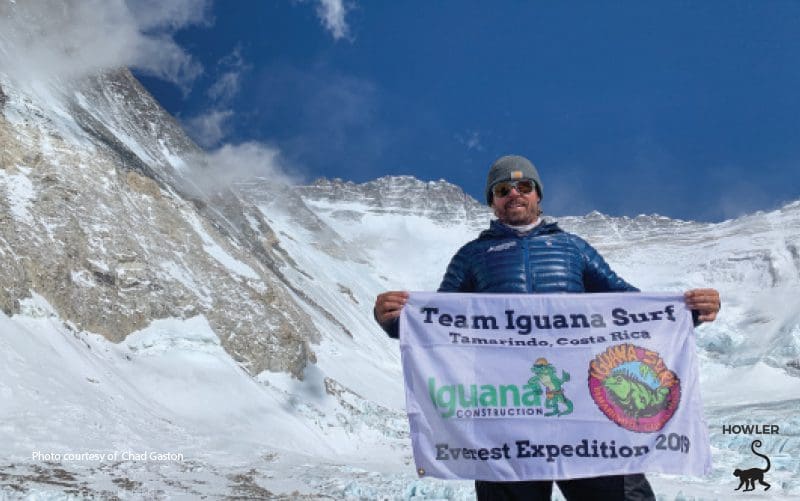Mount Everest: One Local’s Quest to Scale the Summit
Mount Everest: One Local’s Quest to Scale the Summit. Imagine scaling the highest mountain in the world only to wait in line to reach the summit. Even for an experienced climber like Tamarindo’s Chad Gaston, this was more than an inconvenience — it was a life or death scenario.
“There was not one moment from the time I started climbing ‘til I got back that I was not constantly calculating the odds of survival,” he revealed during a Howler interview in early June, just days after returning home to Costa Rica.
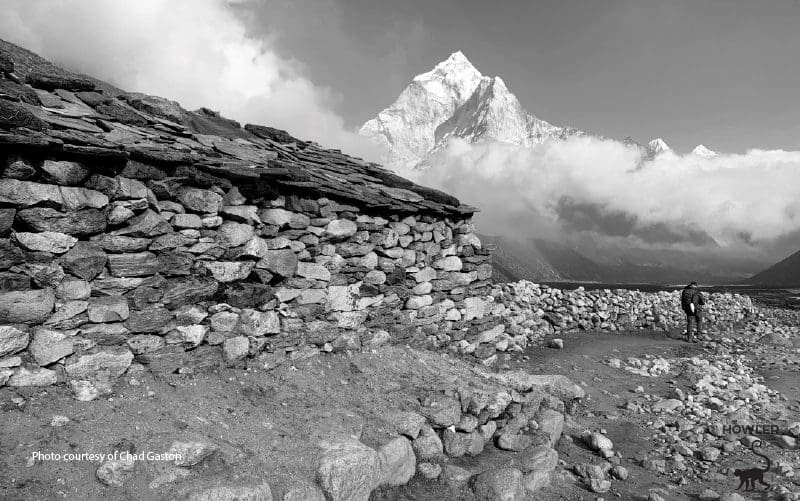
Yak Ranch in Pheriche
Intensive preparations
Jutting over 29,000 ft. into the air, nature’s raw power creates deadly conditions that only those who have experienced Mount Everest will ever truly comprehend. Reaching the tip of this Himalayan peak is far from a simple jaunt up the mountain during a weekend trip. Chad spent a total of eight weeks in the frigid climate acclimating to the altitude, honing his skills and preparing for the grueling push to the top.
‘I remember just letting it all go
when I got to my tent … relief I had made it
and grief for those who had not.’
“Over the last four years, I have built-up my mountaineering experience, practiced emergency scenarios, and trained my body both physically and mentally.”
Since 2015, Chad has successfully climbed Mt. Kilimanjaro, the Carstensz Pyramid, Mt. Rainier and Aconcagua. His trip up Alaska’s Denali mountain was cut short by a nine-day storm that left them stranded at 14,000 ft. Mount Everest marks his fifth climb in nearly as many years.
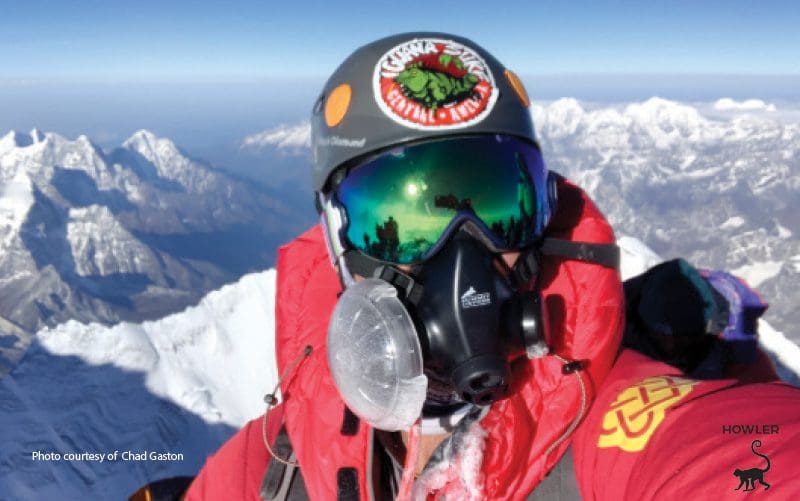
Chad taking a selfie at the top of Everest.
Undeterred by risk
Although conquering these highest peaks on earth is a relatively new endeavor, Chad is no stranger to a lifestyle full of adventure and risk. During his first visit to Costa Rica while in college, he was presented with a unique opportunity — to own and operate a surf shop in Tamarindo. At only 22 years old, Chad completed his degree and immediately moved to the then-relatively undeveloped Guanacaste coastal town. Most would consider this one of the riskiest decisions a young man could make, especially given his lack of Costa Rican contacts and inability to speak Spanish.
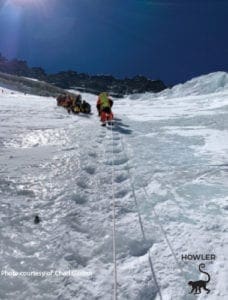
Steps kicked into the Lhotse face above Camp 3
Despite the challenges, Chad has started multiple successful businesses around Tamarindo over the last 17 years. He considers Costa Rica his adopted home from which he explores the vistas of the world. Adventure, risk — these concepts are stitched into Chad’s lifestyle and turned an adolescent American into an awe-inspiring explorer.
Mount Everest is no walk in the park. Preparing for such a journey requires much more than physical stamina and mental fortitude. Avalanches, triple-digit wind speeds and negative temperatures low enough to give bare skin frostbite in less than a minute — these hazards only increase as climbers trudge farther into The Death Zone. At elevations higher than 26,000 ft., the body can’t survive with such limited oxygen levels. Without sufficient oxygen, climbers begin to faint and cells begin to die.
No, you need more than strength and spirit to conquer the revered Nepali Sagarmatha — you need all the help you can get. Thankfully, Chad wasn’t alone in his journey.

The whole Madison mountaineering team arriving at Base Camp
Cross-cultural connectedness
“Our team was comprised of several different cultures,” Chad says, detailing the team of four women and six other men making the climb alongside expert guides and local Sherpas. “By the time it was all over, we were more than a team. We were a family.”
The four women were of Middle Eastern descent, proudly representing Saudi Arabia, Oman and Lebanon (the two Lebanese climbers became the first of their country to summit Everest). These pioneers were overcoming more than a mountain; they were becoming heroes to young women throughout the Middle East.
Every climber has a story. Unfortunately for some, their story ends before the climb is complete.
During the ascent, three of Chad’s male teammates had to end their journey due to altitude sickness and injury.
“I was sad, as I wanted all of our team to succeed,” he said. “I was just thankful they were all able to get down and get care quickly.”
Sobering memorials
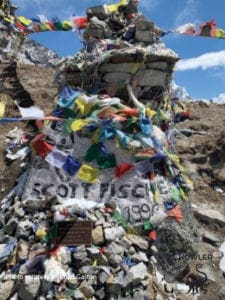
Shrine to Scott Fischer, owner of Mountain Madness, who died during a blizzard on May 11, 1996, the third-worst day in history for Everest climbers
Chad would soon discover, not everyone is lucky enough to make the trip back down the mountain. At roughly 4,000 ft. sits the Pheriche Valley. where shrines memorialize the climbers who did not survive their expedition. Some pass due to injury or illness on the way up while many others succumb to The Death Zone on their descent.
“It was a very sobering feeling,” Chad recalled. “Most of the people who had shrines were very skilled and experienced climbers. All of them set out with the same goals and dreams I had. I realized I needed to be very prepared as well as very lucky.”
Though Chad and the remaining members of his team successfully reached the top of the world and survived the trip back down, he did come face to face with the cold reality that every climber fears. As Chad solemnly trekked past men and women laying lifeless in the snow, an uneasy feeling started to settle in.
“This dream of mine was quickly becoming a nightmare,” he admitted. “Not only did I have to pass over these fellow climbers again, I was going to have to get past the hundreds of climbers who were making their bid for the summit.”
Hazards in the balance

Chad crossing a ladder bridge in the Khumbu Icefall
Chad made it to the peak and back down to camp, but not without taking measured risks. Every breath countsin The Death Zone. The long line of climbers could delay his ascent and
deplete his oxygen tanks. Despite the immense risk of falling thousands of feet into certain death, he unclipped from his safety line and scaled the frozen south face of Everest’s peak via ice axe. At 26,500 ft., he continued his ascent in pitch black darkness during a snowstorm.
“I assessed my personal abilities and knew I could make the climb,” he said. “I also had to think about if I didn’t, and continued slowly, it might take too long to get back down and I could run out of oxygen.”
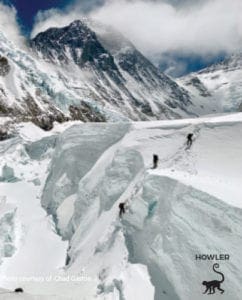
Crossing a large crevasse on the way to Camp 2
Slow and steady was safer, yet he risked oxygen depletion. Urgency increased the risk of falling or succumbing to exhaustion, but if he moved fast enough his oxygen reserves should last until his descent into camp. After conquering the climb and standing atop the highest point on the planet, Chad then had to move against the flow of traffic and make it safely down to camp.
Chad stayed unclipped as he made his way back down the nearly vertical face of the Hillary Step. Exhausted and dehydrated, he collapsed. His oxygen tank was virtually empty. Thankfully, his Sherpa was there to replenish the supply. With a packet of mementoes from his loved ones in hand, Chad got to his feet and continued downward for 13 more hours until he reached camp. More fallen climbers lay frozen on his path.
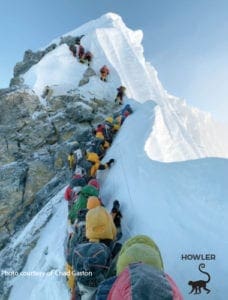
Congestion of climbers waiting to climb the Hillary step on the ridge just below the summit
Relief and grief
“I admit, I had to bury it deep inside and try to focus on the next step and on the next breath. I knew panic and fear were not going to help. But seeing so much death was overwhelming and I remember just letting it all go when I got to my tent … relief I had made it and grief for those who had not.”
Adventure has a price and every climber who attempts this journey understands that The Death Zone is unforgiving. But adventure also has a reward for those who brave the risks. For Chad, it was the opportunity to see the raw, untouched beauty of nature.
“In the mountains, you see no roads, buildings, powerlines. Nature as God intended,” he reflected. “I find the peace and tranquility of the frozen landscape to look so clean, so fresh. The pure white snow and deep blue ice are breathtaking.”
Life-changing impact of Mount Everest
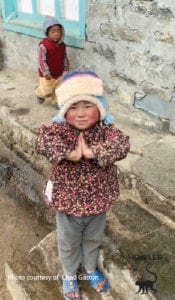
Three year-old Nepalese girl wishing Chad “nameste”
Chad’s two-month challenge on Mount Everest ended in triumph and he’s now safe at home in Costa Rica. The profound impact of his experience has shaped the way he sees the world.
The people of Everest’s rugged and remote Khumbu Valley region, for example, left a lasting impression on him. Their homes do not include modern conveniences like reliable electricity or indoor plumbing. They carry 100-lb. loads on their backs at elevations of 17,000 ft. They live hard lives by any standard, and yet, they are as happy, content and generous as can be.
“We take so much for granted in the modern world,” Chad commented. “We have all of the ‘conveniences’ and ‘instant gratification’. They go about their lives without any of it and they are truly happy! It’s a hard life but they seem to enjoy it.”
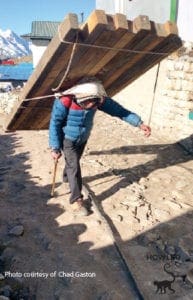
Sherpa carrying supplies from Lukla to Namche
Climbing Mount Everest is a challenge unlike any other. Some of the most experienced and skilled mountaineers cannot complete the task. There is no guarantee of a successful summit, only the certainty that each climber who succeeds will return forever changed for better and worse. For Chad, it’s all part of the adventure — a price he’s willing to pay to obtain a reward only few will ever possess. Ever the adventurer, he’s already preparing for his next life-changing experience.
“I will continue to climb and I want to finish the Seven Summits. Four of my Everest teammates and I are already planning our 2020 expedition to Denali. But the next great adventure I hope to tackle is fatherhood. [Fiance] Tracy and I plan to marry soon and we hope to start a family.”
Life Under the Volcanoes: Costa Rica and the Ring of Fire
Los Quetzales National Park – Costa Rica’s Shangri-La
Earth Day 2019: Now It’s Time to Protect Our Species
Tamarindo Vibes- Reasons Not to Want it Any Other Way
Monteverde Cloud Forest: The Fairytale I Imagined
Sewing A Different Pattern on and off the Waves
Safari River Float is a Slow Boat to Paradise
7 Days in Costa Rica (Arenal, Dominical and More)
Lucky Lovers Leap into Adventure of a Lifetime
Navigating Bocas del Toro, Panama
ATV Tours, Take the Road Not Taken
Arenal – Choose Your Adventure
Rainforest Adventure Tram Trip
Cocos Island, Costa Rica’s Treasure

